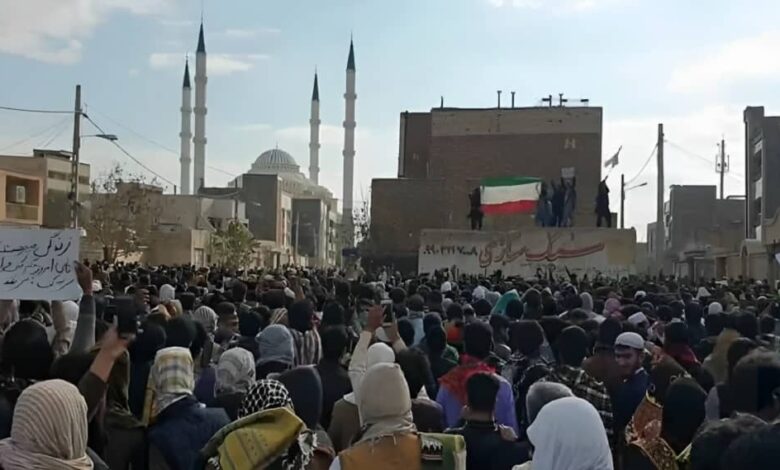Stats Tell Why Iran’s Sistan and Baluchestan Province Proved Regime’s Crackdown Useless

Iranian Baluchis Respond to Mohsen Shekari Execution (1)
Written by
Mahmoud Hakamian
Despite the attempts of the clerical regime to prevent a resurgence of the uprising on the anniversary of Bloody Friday, a day that commemorates the tragic massacre during Friday prayers in Zahedan on September 30, 2022, the people of Sistan and Baluchestan Province contradicted the regime’s assertions of control and suppression of the popular desire for change. Over the past three days, the resilient population of this province demonstrated their discontent through protests, strikes, and nightly confrontations, signaling that Iran’s emerging revolution continues despite the regime’s attempts to quell it.
For decades, under consecutive dictators in Iran, Sistan and Baluchestan province has been one of the most impoverished and underdeveloped regions in the country. This is evident in the province’s staggering socioeconomic inequality, which is characterized by high levels of unemployment, poverty, and income disparity.
According to the Statistical Centre of Iran, the average annual income of rural households in Sistan and Baluchistan province slightly exceeded 44 million tomans in the year 1401 (March 2022- March 2023), representing a significant 55.3% deviation from the national average for rural households in Iran. Additionally, the annual average income for urban households in this province was approximated at 107,737,300 tomans, marking a distinct 35.4% decline compared to the national average annual income for households in Iran during the same period.
This severe income disparity is further underscored by the Gini coefficient of 0.4647 for urban areas within the province during the year 1401, which is significantly higher than the national average of 0.406.
The province’s socioeconomic inequality is not only reflected in its income distribution but also in its labor market. The unemployment rate in Sistan and Baluchestan province stands at 12.5%, the highest among the 31 provinces of Iran. This rate is 4.3 percentage points higher than the national average unemployment rate of 8.2%.
Furthermore, the employment ratio in Sistan and Baluchestan, indicating the proportion of the population of working age engaged in work, is the lowest among Iranian provinces, at 30.6%. This is 7.2% lower than the national average employment ratio.
#Iran: Sistan&Baluchestan Province: Blood and Pain
In Iran, Sistan&Baluchestan province is always without a doubt a part of every single conversation relating poverty, malnutrition, lack of facilities, water shortage, unemployment,&education difficulties. https://t.co/UdnRbxa8Io pic.twitter.com/eJkKESlfVN— NCRI-FAC (@iran_policy) September 14, 2018
The province’s labor force participation rate, which measures the proportion of the working-age population that is either employed or unemployed, is also among the lowest in the country, at 35%. This rate is 6.2 percentage points lower than the national average.
The socioeconomic inequality in Sistan and Baluchistan is compounded by high levels of inflation. The province’s average inflation rate in the “Food, Beverage, and Tobacco” category in September of this year was reported at 68.1%, approximately 10 percentage points higher than the national average.
The clerical regime, characterized by its tendency for deception and fearmongering, has exhaustively employed tactics that evade acknowledging the truth. On September 29, the IRGC-run Fars News agency published a report on the 2022 Zahedan uprising as an attempt to downplay and delegitimize the protests. By claiming that the uprising was “criminal” and “tied to foreign powers and dissident groups,” the regime tried to convey the message that the protests were not the result of genuine grievances among the people, but rather the work of outside forces.
Instead of addressing the underlying socio-economic and political crises, the regime has employed a spectrum of political, social, and security strategies to establish control within the restive province. In the lead-up to the anniversary of the 2022 uprising, significant security preparations were made to suppress any resurrection of protests, particularly in Sistan and Baluchestan.
However, the resilient populace of this province, guided by valiant Resistance Units and the rebellious citizens of various towns like Zahedan, Khash, Sarbaz, Iranshahr, and Rask, demonstrated to both the regime and the nation at large that, despite the extensive military deployment, their determination for regime change is stronger than ever.
September 30—Zahedan, southeast #Iran
The people of Shirabad district hold nightly protests on the anniversary of the Bloody Friday massacre despite heavy security measures by the regime.#IranProtests #جمعه_خونین_زاهدان pic.twitter.com/nM2kVqoCXq— People's Mojahedin Organization of Iran (PMOI/MEK) (@Mojahedineng) September 30, 2023

